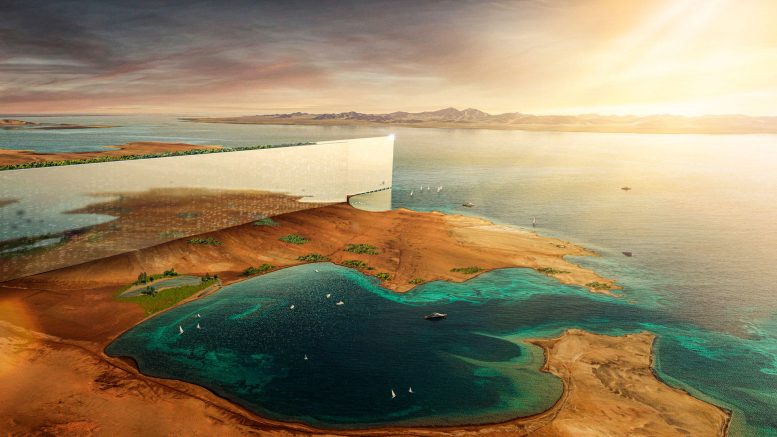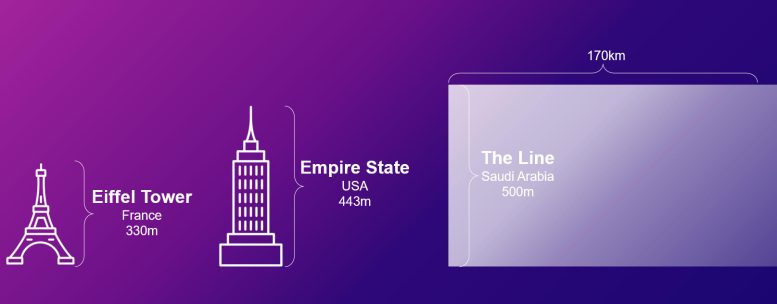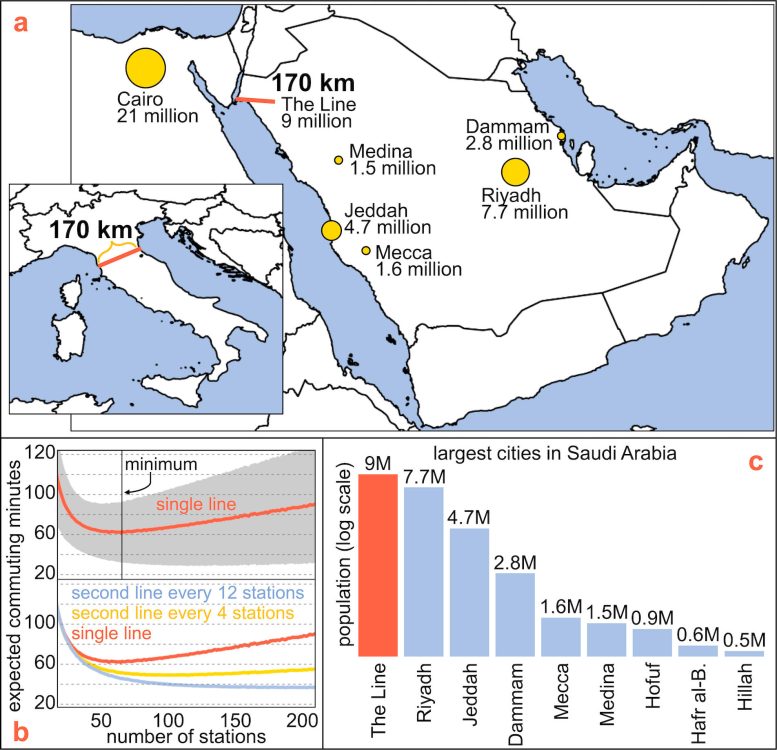
Saudi Arabia’s The Line proposes a futuristic, ultra-dense, linear city, but researchers argue its design is inefficient for transportation and mobility. While marketed as sustainable, the project’s high material costs and construction emissions undermine its eco-friendly claims. Experts warn that The Line may be more about spectacle than functionality.
In October, the excavation work for the superlative construction project began. While some view it as a perfect example of an eco-friendly urban area, others dismiss it as a mere publicity stunt. Now, scientists from the Complexity Science Hub demonstrate the reasons why The Line should not serve as a model for the cities of tomorrow.
“It’s the embodiment of the dream to start from scratch and completely rethink a city,” says Rafael Prieto-Curiel, who researches cities at the Complexity Science Hub. The Line is planned to be a city built from nothing in the desert. It is to consist of two gigantic, unbroken rows of skyscrapers, with living space in between. 170 kilometers (106 miles) long. 200 meters wide. 500 meters (660 feet) high, higher than any building in Europe, Africa, and Latin America. String straight ahead from the Red Sea to the east.
Ten Times Denser Than Manhattan
Nine million people are expected to live in it – more than in any other city in Saudi Arabia. This translates into a population density of 265,000 people per square kilometer – ten times denser than Manhattan and four times denser than the inner districts of Manila, currently estimated to be the densest urban neighborhoods on Earth. “How you can attract that many people in a medium-sized country at all is yet to be observed,” Prieto-Curiel points out.

Sixty Minutes for a Trip
Further questions arise in terms of mobility. “A line is the least efficient possible shape of a city,” says Prieto-Curiel. “There’s a reason why humanity has 50,000 cities, and all of them are somehow round,” he emphasizes.
If we randomly pick two people in The Line, they are, on average 57 kilometers (35 miles) apart. In Johannesburg, which is 50 times larger in area, two random people are only 33 kilometers (20.5 miles) apart. Assuming a walking distance of one kilometer, only 1.2% of the population is within walking distance from each other. This hinders active mobility, so people will depend on public transport.
The backbone of public transportation is planned to be a high-speed rail system. “For everyone to be within walking distance of a station, there must be at least 86 stations,” explains CSH researcher Dániel Kondor. As a result, trains spend considerable time in stations and will not be able to reach high travel speeds between any two stations. According to the researchers, a trip, therefore, is expected to take 60 minutes on average, and at least 47% of the population would have an even longer commute. Even with additional express lines, gains are limited due to the additional transfers necessary. The result is that people would still be traveling longer than in other major cities, such as Seoul, where 25 million people commute for less than 50 minutes.

A City Is More Than a Neighbourhood
Research shows that people want to spend a limited amount of time commuting, so efficient transportation plays a key role in the success of cities. But can these trips through the city be avoided because high density allows everything (jobs, shopping, amenities, etc.) to be available locally? “Cities are more than a collection of semi-isolated 15-minute neighborhoods located next to each other. What sets a city apart from smaller settlements is not just its size but additional opportunities outside the immediate neighborhood – such as concerts or an extended job search. For this reason, we need to consider citywide transportation,” explains Kondor.
Why Not “The Circle”?
If you take The Line and make it The Circle with a radius of 3.3 kilometers (2 miles), the distance between any two people would be only 2.9 kilometers (1.8 miles), and 24% of the population would be within walking distance of each other. Most mobility could be active (walking, cycling, or similar), making a high-speed rail system unnecessary. Alternatively, The Circle could allow good connectivity even with lower densities, avoiding the need for supertall buildings.
Is There Something Positive?
“This project gets people discussing urban forms, and that’s immensely important because cities, especially in Africa, are growing,” says Prieto-Curiel. Historically, cities often grew in organic ways, while planned cities often did not live up to expectations; thus, there is a need for more public engagement in urban design on a human scale.
Additionally, sustainability is emphasized in many aspects of the project. For example, there will be no cars for distances that are no more than a five-minute walk. This not only saves a lot of space in terms of infrastructure and parking but also reduces the number of cars. Moreover, all energy will be produced with zero carbon emissions. What is not taken into account here, however, is the construction of the skyscrapers, which requires a lot of material and energy.
“Overall, it stands to reason that other considerations may have played a role in choosing this unique form, such as branding or creating engaging social media videos. However, it is important to understand the consequences, especially if The Line is treated as a showcase for modern building and urban planning technologies”, emphasizes Prieto-Curiel.
Reference: “Arguments for building The Circle and not The Line in Saudi Arabia” by Rafael Prieto-Curiel and Dániel Kondor, 19 June 2023, npj Urban Sustainability.
DOI: 10.1038/s42949-023-00115-y
Never miss a breakthrough: Join the SciTechDaily newsletter.
9 Comments
Ive created a new urban design that solves a lot of problems to solve the issues laid out here in the article. Its called The Lattice City – https://medium.com/@leonaburime/the-lattice-city-d885ae824c3b
Hope to hear what you think
Very inefficient. What is the goal of this city, to house all SA citizens in one location? Who would willingly move there with increasing warming. It would be nuts to move there.
The line is a creation of an elitist. More money than sense. What about nature? An animal has to walk the length 175 km to get across from one side of the walled city to walk passed this monstrosity. Sounds like someone trying to prove how much further they can urinate than their competitor. We certainly have not come far! I would not live their if you paid me. What am absolute disgrace money is wasted on such extravagance!
What are the odds Mister Bone Saw as he is known in da west is not dumb enough to go ahead and out do dubai’s islands as the most embarrassing yet
The ecological impact of the Line city has not been considered. This project is a demonstration of man gotten brain swollen wasting money just to bull his way into fame. Just look at nature for examples of efficient communities. Bees makes hives. Birds make communities nesting in one tree.
Why waste resources defying gravity in the desert where area is so vast. Now I can say I seen the ultimate madness money can buy.
All I see here is megalomaniacs hell bent on creating a state of the art ghost city. When it’s abandoned halfway through construction.
I wonder what the Bedouin think about this wall in their desert. I wonder what weather patterns will change or originate due to this monstrosity.
A lot of cities have a Main St. And after time high rise development occurs along the main avenues. So in essence they are jumping past all the interim phases to a final form. Hopefully they will have regular underpasses below or through the structure to allow travel without a 175 mile detour. Obviously a single high speed line will not work.They will need a people mover system to gather people to hubs for the high speed train which might only have four stops including each end. The people mover system can be achieved with autonomously driven electric vans and limousines.
With all AI drivers there are no collisions and no traffic jams.There would be no need for food stores as automatic to door delivery by robo servers can bring it. Waste can be efficiently gathered and recycled. With sewage processing to create compost to regrown the desert.
An AI system will be required to run this city. But since it involves a lot of duplication that is ideal for a computer.
Seems to me it’s a great way to regulate classes of people and once born into a class your stuck in that class . Just another form of oppression on society’s. Reminds me of the novel George Orwell 1984. As a reference of control classes and subclasses of people.